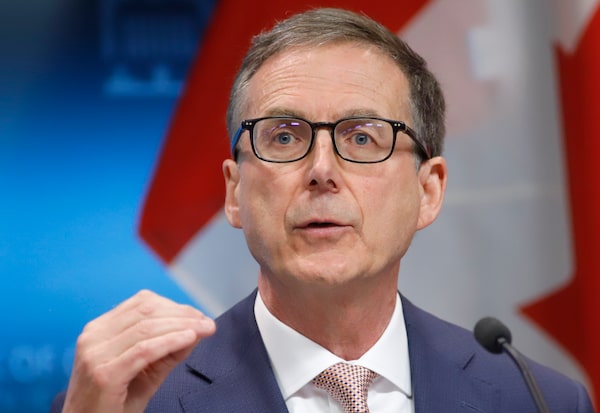
Governor of the Bank of Canada Tiff Macklem speaks at a press conference in Ottawa on June 9.PATRICK DOYLE/The Canadian Press
The U.S. Federal Reserve has just raised the bar on using interest rates to attack inflation. Now, the Bank of Canada has a few short weeks to decide whether it will follow.
It should do so.
In a historic rate decision Wednesday, the Fed raised its benchmark federal funds rate by a huge 75 basis points – three-quarters of a percentage point – to a range of 1.5 per cent to 1.75 per cent. Normally, rate increases at the Fed are done in 25-basis-point increments; this increase was triple the norm, and the biggest in nearly three decades.
But the even bigger news is that the Fed is just getting started. In a news conference following the rate announcement, Fed Chair Jay Powell said the central bank’s next hike, in July, looks to be a coin toss between 50 basis points and another 75. The members of the Federal Open Market Committee – which sets the Fed’s key rate – now project that the rate will reach nearly 3.5 per cent by the end of this year, an increase from their March forecast of just under 2 per cent.
The dramatic escalation has put other central banks on notice, not least the Bank of Canada – which until now had been significantly ahead of the Fed in tightening monetary policy. The Fed has suddenly leapfrogged over its smaller neighbour, which raised its own key rate to 1.5 per cent in early June. And it’s issued notice that it’s going to keep leaping. That accelerated rate path that the Fed has now mapped out may force some tougher questions on the Bank of Canada.
The Bank of Canada generally doesn’t feel too compelled to match the Fed’s steps. But in this case, it has both motive and opportunity to keep up with the Joneses, with its own 75-basis-point hike in its next rate setting in mid-July.
Bank of Canada will need more than tough talk to show efforts to tackle inflation are working
Though the bank would never admit it, keeping the Canadian rate above that of the United States would, generally, be favourable for the Canadian dollar, as higher rates attract currency investors. Officially, the Bank of Canada doesn’t care about the dollar’s exchange rate; but it knows very well that a stronger loonie means lower prices for Canadian consumers for imported goods. In other words, a strong dollar is a beneficial tool in easing inflation pressures, at least in the relatively near term.
The Fed knows this, too, and certainly doesn’t mind that its increasingly aggressive rate stance has lit a fire under the greenback. The Canadian dollar has fared better than most against its U.S. counterpart in recent weeks, in part because of the Bank of Canada’s own acceleration of rate hikes (50-point increases in April and June). The bank will likely see value in re-establishing this competitive advantage.
Indeed, the Bank of Canada already looked prepared for its own 75-basis-point hike well before the Fed’s dramatic step Wednesday. In raising its rate by 50 points in early June, the bank stated that it “is prepared to act more forcefully if needed” to bring down inflation. In a news conference the next day, deputy governor Paul Beaudry elaborated that “more forcefully” meant that the bank was willing to make both bigger individual rate increases, and to ultimately raise rates to a higher peak.
Bank of Canada Governor Tiff Macklem and Fed Chair Powell have both said that they want to get their respective rates into what they consider neutral territory – where the rate is neither stimulating nor inhibiting economic activity – as quickly as possible. For both central banks, that’s estimated to be somewhere between 2 per cent and 3 per cent – for the sake of convenience, then, call it 2.5 per cent.
With the Fed having already established the 75-point precedent, it opens a door, in terms of public and financial-market psychology, for Mr. Macklem to take a similar leap in the bank’s next rate setting on July 13, which would get Canada’s rate very close to neutral.
Of course, he’ll get to see a few more key economic data points before he and his colleagues make that decision. Most crucial will be the May inflation numbers, scheduled for release next Wednesday.
Mr. Powell pointed to last week’s U.S. inflation numbers, which exceeded the Fed’s forecasts, as the main justification for the central bank’s 75-point rate hike. Mr. Macklem may well receive a similar green light from the Canadian data next week.
The Canadian central bank has repeatedly talked about the potential to take a pause in its hikes once it has reached neutral, in order to assess the impact that higher rates are having on the economy, although it has allowed that rates might have to exceed neutral for a while to cool excess demand. But the Fed was abundantly clear Wednesday that it expects to exceed the neutral point by the end of the year, and creep even higher next year.
The Canadian economy doesn’t have as much excess demand, nor as high inflation, as the U.S. economy. While Mr. Macklem and his team may be motivated to get to neutral before the Fed does, they will have to decide just how far they want to follow the Fed beyond that point – and how long they can wait to make that determination.
Your time is valuable. Have the Top Business Headlines newsletter conveniently delivered to your inbox in the morning or evening. Sign up today.
 David Parkinson
David Parkinson